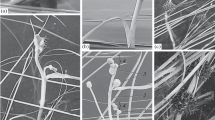Abstract
Sargassum thunbergii growing on the sheltered coast of Maizuru Bay, which faces the Japan Sea, has been ecologically studied. The alga is perennial, its basal part (holdfast and stem) persisting even after its primary laterals have decayed. The alga forms a conspicuous zone especially in the summer. In the winter the plant is small and its growth is very slow. After that, with the rising of both temperature and tidal levels the alga grows progressively both in length and weight, and also forms numerous lateral branches. In summer (July to August) when the tidal levels are high (+21 cm to +43 cm), the alga is always submerged. At this time, the water temperature reaches the highest in the year (27–29 C), and the alga attains its maximum length and weight. Simultaneously, maturation occurs, and soon afterwards its primary laterals rapidly decay away, while young primary laterals beging to grow.
Formae ofSargassum thunbergii (f.typicum, f.latifolia, f.nipponicum and f.swartzianum), which were established by Yendo (1907) and by Okamura (1923) are also discussed in terms of their ecology.
Similar content being viewed by others
References
Baardseth, F. 1970. Seasonal variation inAscophyllum nodosum (L.) Le Jol. in the Trondheimsfjord with respect to the absolute live and dry weight and the relative contents of dry matter, ash and fruit bodies. Botanica Marina13: 13–22.
Chauhan, V.D. andV. Krishnamurthy. 1971. Ecology and seasonal succession ofSargassum swartzii (Turn.) C. Ag in Indian waters. Phykos10: 1–11.
David, H.M. 1943. Studies on the autecology ofAscophyllum nodosum Le Lolis. J. Ecol.31: 178–198.
Fuse, S. 1962. The animal community in theSargassum belt. Seiri-Seitai11: 23–45. (in Japanese).
Knight, M. 1947. A biological study ofFucus vesiculosus L. andFucus serratus L.. J. Linn. Soc. Lond., Bot.159: 87–90.
— andM. Parke. 1950. A biological study ofFucus vesiculosus L. andFucus serratus L. J. Mar. Biol. Ass. U.K.29: 439–514.
Nakamura, Y., M. Tatewaki, H. Nakahara, S. Saito, K. Nagata and M. Masuda. 1970. On the productivity of marine algal communities. Interim Rep. of the Kuroshio Littoral Region Research Group for JIBP-PM., pp. 7–9. (in Japanese)
Nakamura, Y., M. Tatewaki, H. Nakahara, S. Saito, K. Nagata and M. Masuda. 1971. The seasonal variations of standing crops ofSargassum thunbergii. Interim Rep. of the Kuroshio Littoral Region Research Group for JIBP-PM., pp. 15–17. (in Japanese)
Okamura, K. 1923. Icones of Japanese Algae5: 1–19.
Subrahmanyan, R. 1948. An account of the growth and periodicity in reproduction inPelvetia canaliculata Dene. et Thur. Proc. Challenger Soc.2: 15–16.
— 1960. Ecological studies on the Fucales I.Pelvetia canaliculata Dene. et Thur. J. Indian Bot. Soc.39: 14–30.
Yendo, K. 1907. The Fucaceae of Japan. J. Coll. Sci., Imp. Univ. Tokyo21: 1–174.
Author information
Authors and Affiliations
Rights and permissions
About this article
Cite this article
Umezaki, I. Ecological studies ofSargassum thunbergii (Mertens) O. Kuntze in Maizuru Bay, Japan Sea. Bot Mag Tokyo 87, 285–292 (1974). https://doi.org/10.1007/BF02489559
Received:
Issue Date:
DOI: https://doi.org/10.1007/BF02489559




